My first glimpse of Olduvai Gorge was through dusty sunglasses and a dusty windscreen. Spread out below me was the Y-shaped gorge, stepped walls, dusty green acacia trees and spiky oldupai plants with the white, coarse quartzite of Naibor Soit glistening in the distance. Over a decade later and a total of more than a year spent camping there, the thrill of the first sight of the gorge has not diminished. It is always a delight to visit this famous hominid locality, home of the early hominid, Zinjanthropus boisei, in the Ngorongoro Conservation Area, northern Tanzania.
I am part of a multinational team of scientists who have been excavating the 2 million year old sediments of an ancient lake, searching for fossil evidence of the past vegetation, animals, rivers and lake shores that was the home of two of the early hominids. The site was made famous in 1959 when Mary Leakey discovered the first African fossil hominid, the skull of Zinjanthropus boisei (renamed Paranthropus or Australopithecus boisei). Later, another skull was found, Homo habilis, and many stone tools that are now known as the Oldowan culture or technology, the oldest known stone tool technology. It is not clear which hominid made the tools as there are many stone artifacts and very few hominid skeletal remains. This team, the Olduvai Landscape Palaeoanthropology Project, or OLAPP, began work in 1989 with Fidelis Masao, Rob Blumenschine, Jim Ebert and Richard Hay, the geologist who had worked with Mary and Louis Leakey.
________________________________________________________________________________________
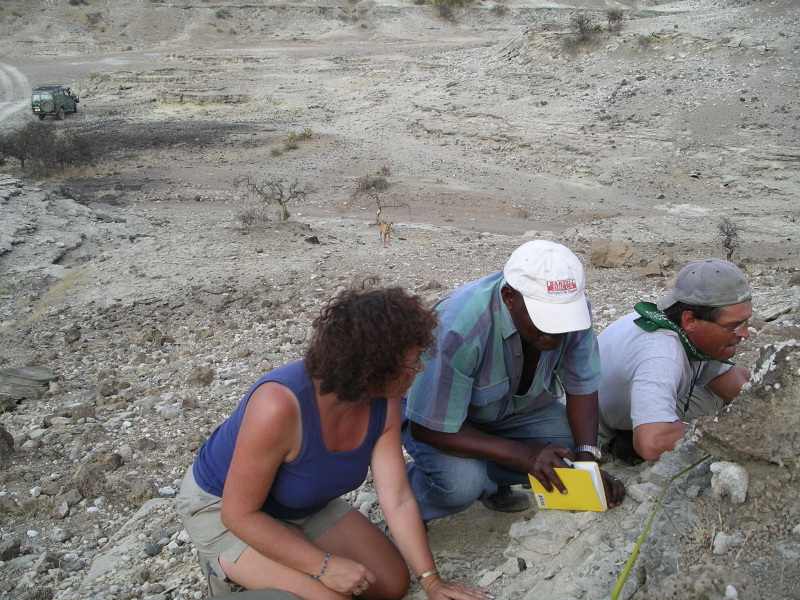
Carefully examining the sediments and biotic traces in the field are Marion Bamford, Fidelis Masao and Rob Blumenschine.
_____________________________________________________________________________________________________________________________________________
I joined the team in July 2000 to study the fossilized wood and sedge fragments. It was a very steep learning curve to remember the site names, stratigraphic layers, ages of the tuffs and to visualize the ancient lake that was located where today there are only dry dusty sediments exposed by the “river” erosion. This river only flows a few times a year and seldom in the dry season when we conduct our annual field season. Site names are in honour of the Leakeys and their colleagues — FLK, named after Frida Leakey Korongo (korongo = erosion gully), HWK (Henrietta Wilfrida Korongo), MNK, (Mary Nicol Korongo), DK (Douglas Korongo), and many more. My first excavation took place at MNK through Bed II strata (about 1.8 million years B.P.) under the close supervision of Joanne Tactikos and Augustino Valentin. I labored to recognize the differences between the sediments, the gritty grey tuffs (a type of rock consisting of consolidated volcanic ash ejected from vents during a volcanic eruption), augitic sandstones, waxy claystones formed in the lake bottom and the earthy claystones formed in the river channels. Within these confusing layers were fossil bones of elephants, rhinos, bovids and carnivores, as well as stone cores, manuports and flakes. But for me the most interesting finds were the pure white fragments of wood, sedge and grass stems and other plants. Under the microscope, I could see the details of internal plant anatomy with vascular bundles, pith, wood tissue and some structures that I could not recognize. From the first field season there were more questions than answers and a desperate wish to return the next year – and the next.
________________________________________________________________________________________
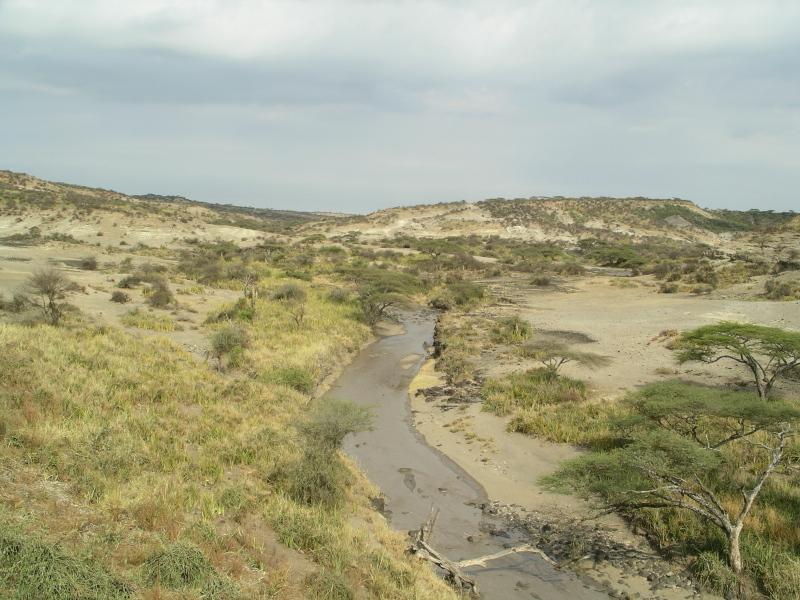
Rare occurrence of the Olduvai river flowing in July.
________________________________________________________________________________________
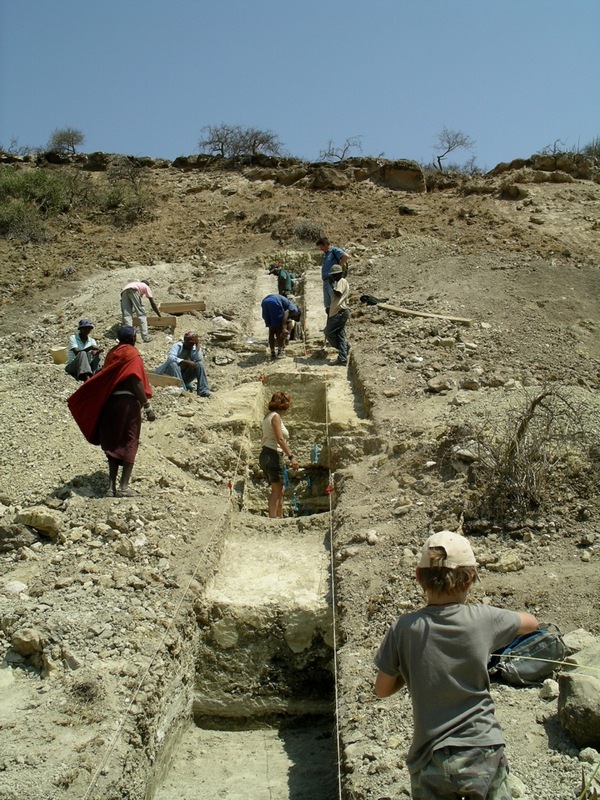 Here we dug a geotrench – a stepped excavation into the eroding side of the gorge to map in detail the sedimentary layers and collect stone artifacts, bones, plant macroremains and microremains. The tuffs are used to correlate layers in the numerous trenches across the gorge.
Here we dug a geotrench – a stepped excavation into the eroding side of the gorge to map in detail the sedimentary layers and collect stone artifacts, bones, plant macroremains and microremains. The tuffs are used to correlate layers in the numerous trenches across the gorge.
______________________________________________________________________________________________________________________
As so little botanical research has been done on similar aged sites with unusual preservation of fossil plants, another member of OLAPP, Charles Peters, and I had to look for living settings with similar vegetation types. From the fossils we knew that there were sedges and river sediments with volcanic ash layers in between, and this suggested an ancient landscape consisting of a wetland with active volcanoes nearby. Modern analogous localities were the shallow lake of Ol’Balbal nearby, Lake Makat in the Ngorongoro caldera, Lake Masek, Lake Ndutu and Lake Manyara. Together with the vertebrate paleontologists we visited these sites each year to monitor the vegetation (and breakup of animal skeletons). Unfortunately, these lakes and their associated wetlands were very saline and alkaline because of the volcanic ash and so the vegetation had a much lower diversity than our fossil wetlands. Therefore, we looked for fresh water wetlands in areas that were undisturbed by people and livestock. We also needed to find places that we could visit frequently and not be attacked by dangerous animals. Otherwise, we could become fossils ourselves! The Serengeti National Park, which is near our research area, has grasslands, woodlands, lakes, rivers and wetlands together with lions, crocodiles, hippos and buffalo. We eventually found several national parks in Southern Africa that were suitable and there we have safely mapped the vegetation, waded through wetlands, collected plants and plant fragments in order to understand the possible settings in which early hominids might have foraged for plant food, animal carcasses and found fresh water to drink.
_________________________________________________________________________________________
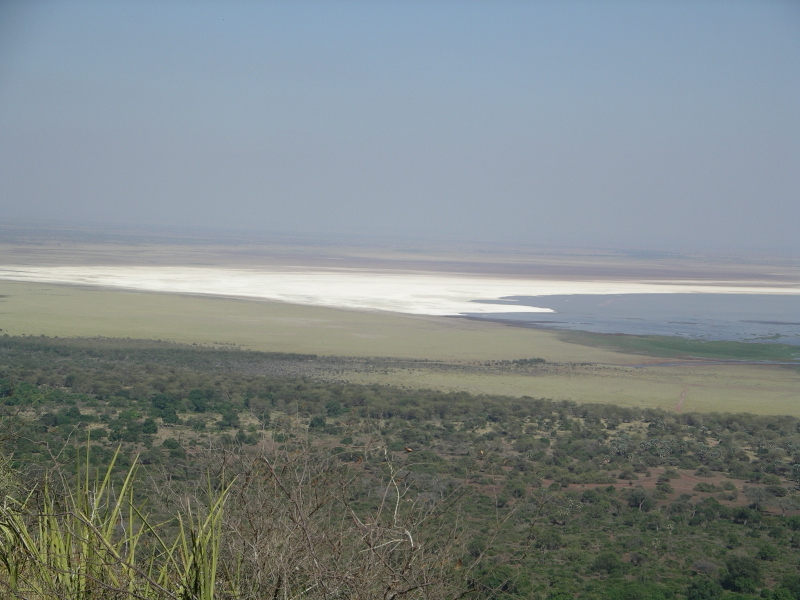
View over the south end of Lake Manyara where we have studied the modern vegetation. Note the expanse of white trona (dried out saline and alkaline lake salts) and the narrow channel of fresh water flowing into the lake and forming a large bright green wetland of sedges.
________________________________________________________________________________________
A few years later Rosa Maria Albert, from Spain, joined the team. Her specialty is phytoliths. These are microscopic silica bodies that form inside some plant cells. They take on the shape of the cell but when the plant dies and rots away the phytoliths remain in the soils or fossilized sediments. The conditions required for the preservation of the larger plant fragments and for the phytoliths are different, so some fossil layers preserve one or the other, or both. Preserved pollen gives us another line of evidence of past vegetation, but is not often found at Olduvai. We collect and study all three types of botanical remains to reconstruct the past vegetation (Albert et al., 2006; Bamford et al., 2006).
Because we are attempting to reconstruct the ancient ecosystems (plants, animals, topography) we use all fossil remains available, as well as the geology. For example, from the small mammal bones found in fossilized owl pellets we know that there must have been roosting trees near the lake shore during uppermost Bed I times at FLK, but we could find no direct evidence of trees. In 2008, after very careful excavation of each thin sedimentary layer, we found casts of branches of trees or shrubs lying horizontally alongside a bank. We were thus able to complete the picture.
Also, along the eastern shore of the palaeolake we have found patches of a dry, weathered, grassland with the basal culms (stems) and the rhizomes silicified and preserved exactly where they were growing. Looking carefully at the plant layer and the overlying sediments, we were able to reconstruct the environment. All that remained of a large area of grasses and small herbs alongside the drying lake were the roots, rhizomes and basal culms (Bamford et al., 2008). This dry vegetation was then covered rapidly by a thin layer of mud, perhaps a heavy rainfall and rising lake water, only to be completely buried – and preserved – by a thick layer of volcanic ash from an erupting volcano nearby. Bones and stone tools were also preserved by this thick ash of Tuff about 1.8 million years ago.
_________________________________________________________________________________________
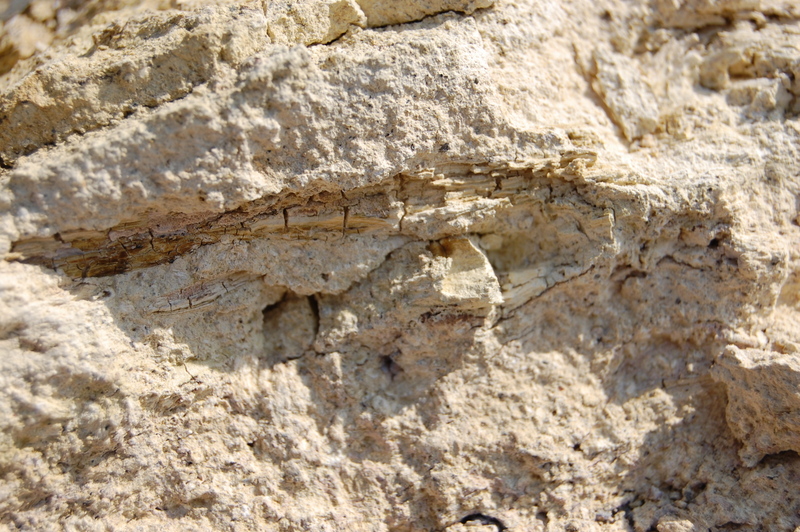 Cast of a woody branch from FLK site, about 20mm in diameter, provides evidence that there were woody plants growing on the peninsular at the time of “Zinj”.
Cast of a woody branch from FLK site, about 20mm in diameter, provides evidence that there were woody plants growing on the peninsular at the time of “Zinj”.
_____________________________________________________________________________________________________________________
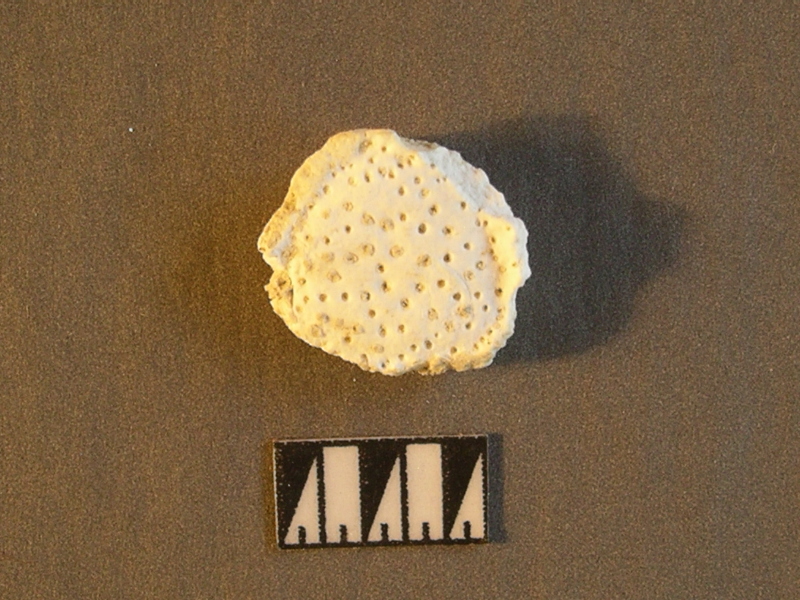 View of the internal anatomy of the basal culm of a sedge. The holes contain the vascular bundles.
View of the internal anatomy of the basal culm of a sedge. The holes contain the vascular bundles.
______________________________________________________________________________________________________________________
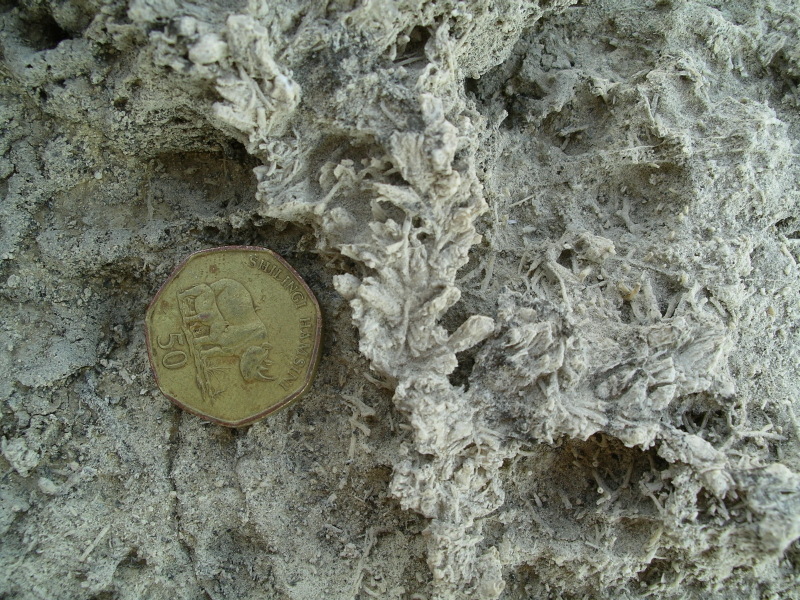 Fossil grassland – silicified weathered basal culms of a grass attached to a horizontal rhizome. Coin for scale = 15mm diameter.
Fossil grassland – silicified weathered basal culms of a grass attached to a horizontal rhizome. Coin for scale = 15mm diameter.
_____________________________________________________________________________________________________________________
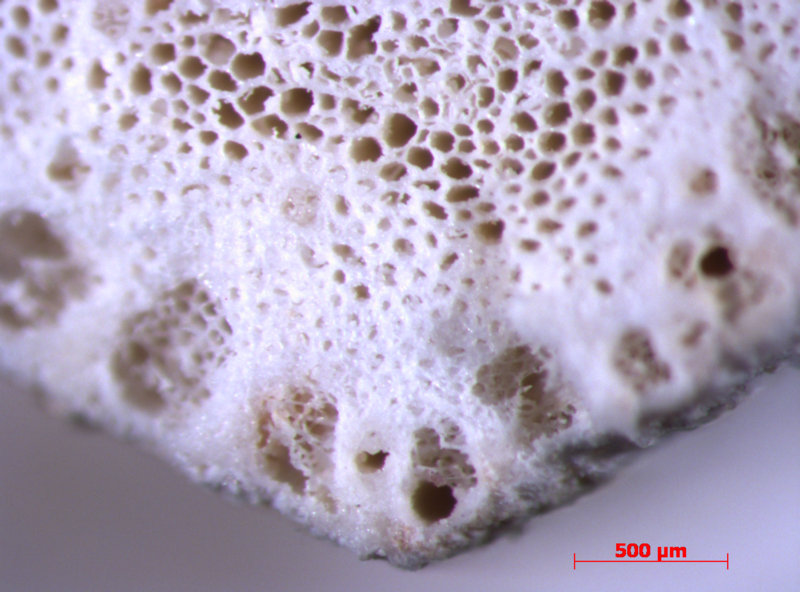
Section of a triangular sedge showing the arrangement of the vascular bundles and canals inside the stem.
_______________________________________________________________________________________________________________________
Over the years I have collected many fossil and modern samples, always looking for something different (Bamford 2012). We have visited and sampled other vegetation types, such as the delta and flood plain of Lake Eyasi, the forest at Gombe on Lake Tanganyika, and the open grasslands, kopjies and riverine woodlands in the Serengeti. Working closely with the geologists Ian Stanistreet and Harald Stollhofen, and the palaeontologists Rob Blumenschine, Jackson Njau, Charles Peters and Peter Andrews, we have developed an ecological model for the site where the cranium of “Zinj” (OH5, Paranthropus boisei) was found.
At the time of Zinj, (1.84 Ma) there was more topographical relief than expected at FLK with a peninsular that extended out into the freshwater lake, on the east shore of the palaeolake Olduvai. On one side of the peninsular (Mary Leakey’s FLK NN1 site) was a permanent wetland vegetated with Typha (cattail or bulrush) and various sedges. On the other side of the peninsular were freshwater river channels that fed water into the lake (FLK Fault and Mary Leakey’s site FLK 22). On this narrow peninsular, slightly raised above the water level, were groves of broad-leaved trees and palms where carnivores could prey on animals drinking water and hominids could scavenge the carcasses, collect water and forage for plant foods such as sedge rhizomes and perhaps fruits. The distribution of the stone artifacts and bones supports our scenario and further shows that the sites were not occupational floors but rather sites of scavenging and butchery activity (Blumenschine et al., 2012).
My research at Olduvai is not finished. There are other sites along the ancient shores and hundreds of thousands of years to research. There may not be many fossil hominids at Olduvai, but there are many landscapes to investigate.
References
Albert, R.M., Bamford, M.K., 2012. Vegetation during uppermost Bed I and deposition of Tuff IF at Olduvai Gorge, Tanzania, based on phytoliths and plant remains. Five Decades after Zinjanthropus and Homo habilis: Landscape Paleoanthropology of Plio-Pleistocene Olduvai Gorge, Tanzania. Journal of Human Evolution 63, 342-350.
http://dx.doi.org/10.1016/j.jhevol.2011.05.010.
Albert, R.M., Bamford, M.K., Cabanes, D. 2006. Taphonomy of phytoliths and macroplants in different soils from Olduvai Gorge, Tanzania: application to Plio-Pleistocene palaeoanthropological samples. Quaternary International 148: 78-94.
Bamford, M.K. 2012. Fossil sedges, macroplants and roots from Olduvai Gorge, Tanzania. Five Decades after Zinjanthropus and Homo habilis: Landscape Paleoanthropology of Plio-Pleistocene Olduvai Gorge, Tanzania. Journal of Human Evolution 63, 351-363.
http://dx.doi.org/10.1016/j.jhevol.2011.07.001
Bamford, M.K., Albert, R.M., Cabanes, D. 2006. Plio-Pleistocene macroplant fossil remains and phytoliths from Lowermost Bed II in the eastern palaeolake margin of Olduvai Gorge, Tanzania. Quaternary International. 148: 95-112.
Bamford, M.K., Stanistreet, I.R., Stollhofen, H., Albert, R.M. 2008. Late Pliocene grassland from Olduvai Gorge, Tanzania. Palaeogeography, Palaeoclimatology, Palaeoecology 257, 280-293.
Blumenschine, R.J., Stanistreet, I.G., Njau, J.K., Bamford, M.K., Masao, F.T., Stollhofen, H., Andrews, P., Fernandez-Jalvo, Y., Prassack, K.A., Albert, R.M., McHenry, L.J., Camilli, E.L., Ebert, J.I. 2012. Environments and activity traces of hominins across the FLK Peninsula during Zinjanthropus times (1.84 Ma), Olduvai Gorge, Tanzania. Five Decades after Zinjanthropus and Homo habilis: Landscape Paleoanthropology of Plio-Pleistocene Olduvai Gorge, Tanzania. Journal of Human Evolution 63, 364-383. http://dx.doi.org/10.1016/j.jhevol.2011.10.001
_______________________________________________________________________________________________________________________
Unless otherwise noted, all photos courtesy Marion Bamford.




